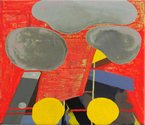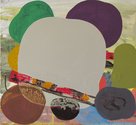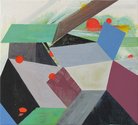John Hurrell – 22 February, 2013
Some of Hooper's new works have a hint of Guston meeting Arp or Hodgkins, with amoeboid or wobbly circular shapes gathered in curving linear formations, often with diagonal bars cutting through agitated mottled washes or stringlike lines wrapped around selected shapes. The paint is thin, granular and often blotchy, its edges restless with undulating contours, while the overall mood is teetering, precarious and biological.
This collection of acrylic abstractions by Julian Hooper has a very different mood than the other painting series he has come up with in recent years - especially his surrealist works, or folk portraits mixing whimsy with black humour, depicting Vlad the Impaler.
Some of Hooper’s new works have a hint of Guston meeting Arp or Hodgkins, with amoeboid or wobbly circular shapes gathered in curving linear formations, often with diagonal bars cutting through agitated mottled washes or stringlike lines wrapped around selected shapes. The paint this time is thin, granular and often blotchy, its edges restless with undulating contours, while the overall mood is teetering, precarious and biological. Not with clean sharp forms as previously.
There are also other sorts of abstraction, more collected fragments of smaller painted units, that suggest grids in their diffuse spatial fields. They could allude to architecture or town planning and have a diffuse airiness, a scattered, tactile, piecemeal quality - a watery or cloudy sensibility.
Rather than constructing tight verbal narratives these images are designed to suggest or hint. Their abstraction is not ultra severe as ‘dry’ or geometric form. Instead they are rich in associative properties, their overlapping, modulated forms tending to create depth. You look through them; they don’t provide an integrated even tension where the canvas edges are under equally balanced pressure. Being organic, their process tends to be unregimented. They don’t seem remotely pre-planned before execution but are totally improvised.
I like the less ethereal ones dominated by squat tubby shapes that could be colliding squishy rubber balls. Hooper’s works I think succeed more with substantially rotund forms that have neighbourly relationships your eye can move through, not with weedy disintegrating elements that are too spread out.
The best have shapes with personality, interacting like rival protagonists in a cartoon strip that, memorable and anthropomorphic, vaguely suggest quirky little dramas, and have titles from rock songsmiths like Joni Mitchell or Nick Cave. Gentle and landscapish, there is a hint of the late Elizabeth Murray, humorous components reduced to smaller elements whimsically performing on a modest stage.
John Hurrell





 Advertising in this column
Advertising in this column Two Rooms presents a program of residencies and projects
Two Rooms presents a program of residencies and projects



This Discussion has 0 comments.
Comment
Participate
Register to Participate.
Sign in
Sign in to an existing account.